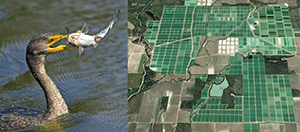NWRC Spotlight - Cormorant Impacts to Catfish

Excerpts from “Fish-eating Birds on Catfish Farms in the Mississippi Delta” by Mississippi State University Extension Service
The Mississippi Delta (Delta) in northwest Mississippi is 200 miles long and 87 miles across at its widest point. It encompasses about 4.5 million acres of floodplains of the Mississippi and Yazoo Rivers. It’s home to blues music, bald cypress trees, fried okra, and catfish farms.
Most of the
commercial catfish production in the United States occurs in the Delta. Catfish aquaculture acreage in the area peaked in the early 2000s, with approximately 134,000 acres of water in production. Since then, aquaculture has decreased by more than 70 percent, with approximately 36,000 acres remaining today.
Today, producers want to know if more cormorants are using fewer acres, whether cormorants are foraging in catfish farms more than natural waterbodies, and how management has impacted cormorant depredation.
To find out, NWRC’s Mississippi field station researchers partnered with Wildlife Services-Mississippi Operations, Mississippi State University, and the University of Arkansas, Pine Bluff. Using similar aerial survey methods as those done in the early 2000s, researchers surveyed cormorant roosting sites and aquaculture ponds in the Delta and compared the data to historic cormorant activity. The following highlights some of the key findings:
- Cormorants that migrate through the Delta come from the Midwestern United States. Fewer cormorants are staying in the Delta now compared to the early 2000s. Past roost counts averaged 33,783 cormorants per survey, whereas today, counts average 12,137 cormorants per survey.
- Although both cormorant numbers and aquaculture acreage have declined in the Delta, cormorant density on catfish aquaculture ponds has not significantly changed since the early 2000s. Today, there are 4.3 to 6.8 cormorants per 100 water acres.
- Cormorants favor natural water bodies early in the winter (October to December) but prefer aquaculture ponds later in the winter (January to April). This shift may happen as cormorants try to improve their body condition in preparation for their northern migration back to the Midwestern United States.
- During 2015, when a U.S. Fish and Wildlife Service Aquaculture Depredation Order (AQDO) was in effect, 40% more cormorants (on average) in the Delta shifted their use from aquaculture facilities to natural waterbodies as compared to 2016 when the AQDO was vacated, and only non-lethal management could be used. In 2017, when depredation permits were allowed, 28% more cormorants were found on aquaculture in the Delta than in 2015 when the AQDO allowed producers to take depredating cormorants from aquaculture facilities without obtaining a migratory bird take permit. The AQDO appears to be more effective than non-lethal methods or the traditional depredation permit system, possibly due to increased risk of mortality on catfish farms under the AQDO.
- Cormorants eat approximately 1 pound of fish per day.
- Commercial catfish make up approximately 33% of cormorant diets in the Delta. During the winters of 2016-2017 and 2017-2018, cormorants consumed 1.2 and 1.6 million pounds of catfish or about 10.3 and 12 million catfish, respectively.
- Cormorant depredation on commercial catfish farms industry-wide results in losses estimated at $47.2 million (range $25.8M- $65.4M) annually depending upon yearly predation levels.
For more results, please see Fish-eating Birds on Catfish Farms in the Mississippi Delta, Cormorant Predation of Commercial Catfish Aquaculture in the Mississippi Delta, or contact NWRC@usda.gov.

